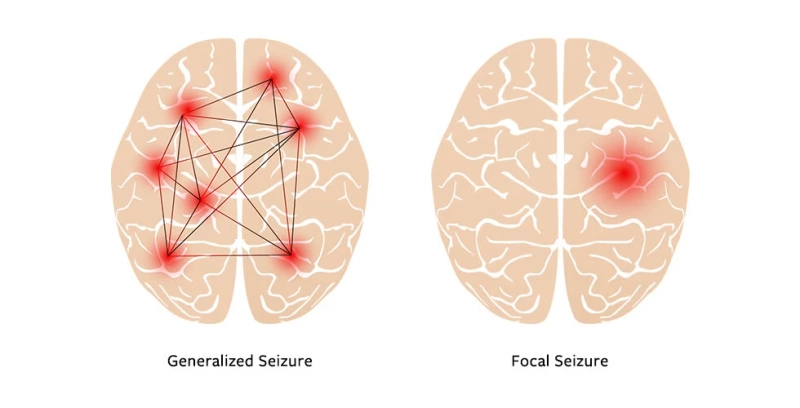Epilepsy is a neurological disorder characterized by recurrent, unprovoked seizures. These seizures result from abnormal electrical activity in the brain, leading to a temporary disruption of normal brain function. While epilepsy can affect individuals of any age, it often manifests in childhood or during the later stages of life. This complex condition poses challenges for those diagnosed and their families, as it requires a comprehensive understanding of its causes, symptoms, and available treatment options.
Causes of Epilepsy:
The origins of epilepsy are diverse, and the causes can be classified into two main categories: structural and functional. Structural causes involve physical abnormalities in the brain, such as tumors, strokes, or developmental malformations. On the other hand, functional causes are often related to imbalances in neurotransmitters or other biochemical factors affecting the brain's electrical activity.
In some cases, epilepsy may have a genetic component, with certain individuals being more predisposed to the disorder due to familial history. However, many cases of epilepsy have no clear underlying cause, making it challenging to pinpoint a single factor responsible for the condition.
Symptoms of Epilepsy:
The hallmark symptom of epilepsy is the occurrence of seizures, which can vary widely in their presentation. Seizures can be classified into two main types: focal (partial) and generalized.
Focal Seizures: Focal seizures originate in a specific area of the brain and may cause localized symptoms. These seizures can be further divided into two categories: a. Simple focal seizures: These seizures do not cause a loss of consciousness and may result in altered emotions, sensory perceptions, or muscle movements. b. Complex focal seizures: These seizures often involve an altered state of consciousness, leading to confusion and unresponsiveness during the episode.Generalized Seizures: Generalized seizures affect the entire brain and can be categorized into different types: a. Absence seizures: Brief lapses in consciousness often mistaken for daydreaming, particularly common in children. b. Tonic-clonic seizures: Characterized by muscle stiffness (tonic phase) followed by rhythmic jerking (clonic phase), loss of consciousness, and potential complications like injuries or biting the tongue.Living with Epilepsy:
Managing epilepsy involves not only medical treatment but also addressing the emotional and social aspects of the condition. Individuals with epilepsy often face stigma and misconceptions, leading to feelings of isolation and anxiety. Educating the individual, their family, and the community at large is crucial in fostering a supportive environment.
Treatment Options:
Medication: The primary approach to managing epilepsy involves antiepileptic medications like Pregabalin M 75 . These medications work by stabilizing electrical activity in the brain, reducing the frequency and severity of seizures. It is essential for individuals with epilepsy to work closely with their healthcare provider to find the most effective medication with the fewest side effects.Ketogenic Diet: In some cases, a ketogenic diet, which is high in fats and low in carbohydrates, may be recommended. This diet mimics the physiological effects of fasting, leading to an increased production of ketones, which can have a stabilizing effect on brain function.Vagus Nerve Stimulation (VNS): Vagus nerve stimulation is a non-pharmacological approach that involves implanting a device under the skin to stimulate the vagus nerve. This method has shown effectiveness in reducing seizure frequency in certain individuals.Responsive Neurostimulation (RNS): For individuals with focal epilepsy who do not respond well to medication, responsive neurostimulation may be an option. This involves implanting a device that monitors brain activity and delivers electrical stimulation when abnormal patterns indicative of a seizure are detected.Surgery: In cases where seizures originate from a specific, identifiable area of the brain, surgery may be considered. The goal is to remove or disconnect the epileptic focus while preserving as much healthy brain tissue as possible.Challenges and Stigma:
Despite advances in epilepsy research and treatment, challenges persist. Stigma surrounding the condition can lead to discrimination in various aspects of life, including employment and social interactions. Increased awareness, education, and open conversations about epilepsy are essential in dispelling myths and fostering a more inclusive society.
The Future of Epilepsy Research:
Ongoing research aims to deepen our understanding of epilepsy, paving the way for more targeted treatments and potential cures. Advances in neuroimaging, genetics, and molecular biology contribute to unraveling the complexities of the disorder. Collaborative efforts between researchers, healthcare providers, and advocacy groups are crucial in driving progress and improving the quality of life for individuals living with epilepsy.
Conclusion:
Epilepsy is a multifaceted neurological disorder that requires a holistic approach to diagnosis, treatment, and support. While significant strides have been made in the field, there is still much to learn about the causes and optimal management of epilepsy. By fostering a supportive and informed community, we can reduce the stigma associated with epilepsy and empower individuals to lead fulfilling lives despite the challenges posed by this condition.


